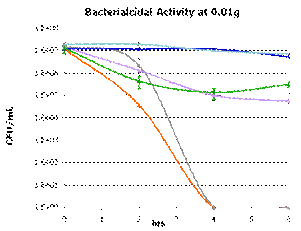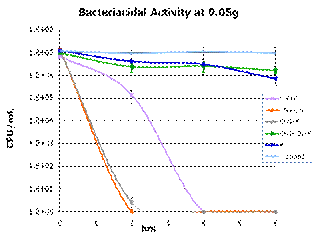Objective: Bone regenerative materials have been successful in the treatment of osseous defects. However, it is well known that infection is frequently the cause of implant failure. The aim of this study is to characterize and determine the antibacterial property of a novel calcium phosphate glass in the family CaO-P2O5-NaF-MgO-ZnO against Streptococcus mutans.
Method: Calcium phosphate glasses (CPG) with and without Zn and/or F were prepared by a melt-quenching method. XRD, SEM, FTIR, ion-selective electrode, pH meter and ICP-MS were used to characterize the experimental samples. To determine bacterial inhibition, 0.01g and 0.05g of bioactive glass, CPG+Zn, CPG+F, and CPG+Zn+F, (n = 4) were incubated with S. mutans for 0, 2, 4, and 6 hours. Serial dilutions were plated in duplicate and colony forming units, CFUs/mL, were determined. Perioglas", C-CPG, and no material were used as controls.
Result: All CPGs demonstrated comparable or better antibacterial activity compared to the commercial control with substantive killing by 4 hours (Figure 1). Antibacterial activity was found to be dependent on solid loading, with 0.05g showing a maximum effect. Interestingly, the bactericidal effect of zinc and fluoride ions was greatest when they were employed separately in the compositions. CPG co-doped with zinc and fluoride ions (CPG+Zn+F) demonstrated higher crystallinity, lower solubility, and thus lower killing.
Conclusion: This family of CPGs, which has previously been shown to have good bone regrowth in vivo, is now demonstrated to have superior bactericidal properties when compared to a commercial control. The combination of these two characteristics makes this material an attractive candidate for bone regeneration.
Fig. 1: Concentration dependent bactericidal activity of CPGs
Keywords: Antimicrobial agents/inhibitors, Bone repair, Dental materials, Fluoride and Remineralization
![[ Visit AADR's Website ]](images/banner.jpg)

